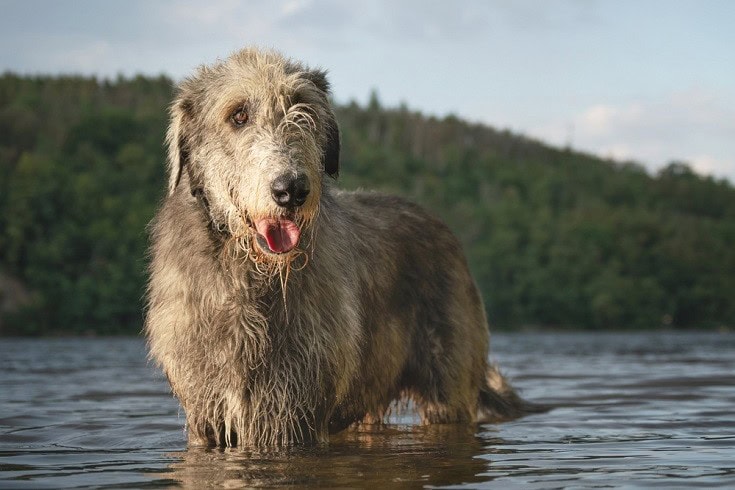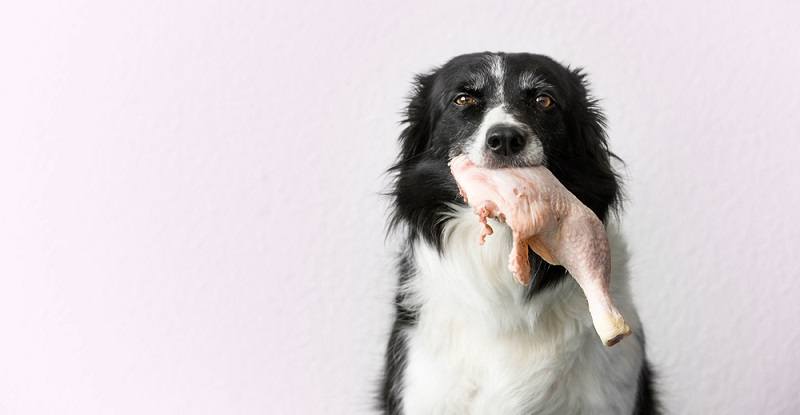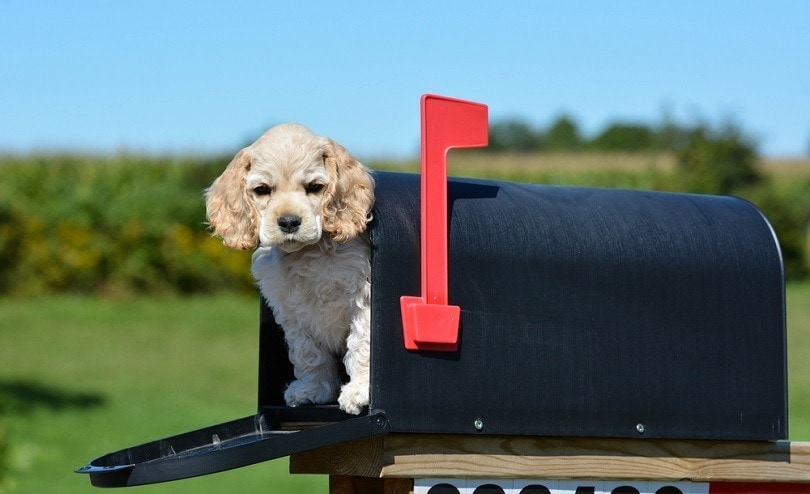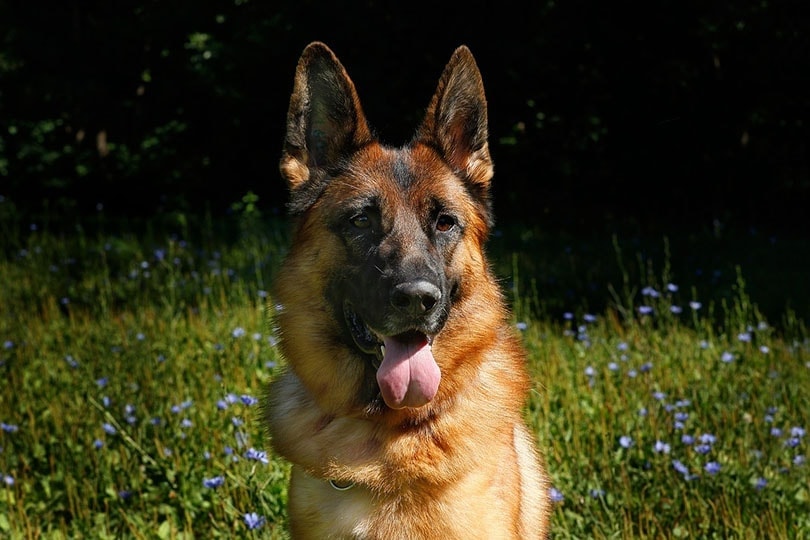Height:
28 – 32 inches
Weight:
105 – 155 pounds
Lifespan:
6 – 8 years
Colors:
Black, gray, brindle, red, fawn, cream, silver
Suitable for:
Active families, those who love giant dogs
Temperament:
Sweet, intelligent, friendly, clumsy, loyal
If you’re torn between getting a dog or a pony, adopting an Irish Wolfhound might be a good compromise. These dogs are absolutely massive, and while they may not be as heavy as some other breeds, they’re as long and lean as a dog can get.
Their size might make you think that these dogs would make excellent guard dogs, but that is usually not the case. These dogs are sweet and trusting, so don’t expect them to stand their ground when an intruder sneaks into your home. They’re much more likely to see if the burglar is willing to make them a sandwich than run them off.
Since many potential owners don’t have the space to contain one of these gargantuan pups, they’re not as popular as many other breeds. As a result, you may not know as much about them as you do other dogs. This guide will change all that.
Irish Wolfhound Puppies — Before You Buy…
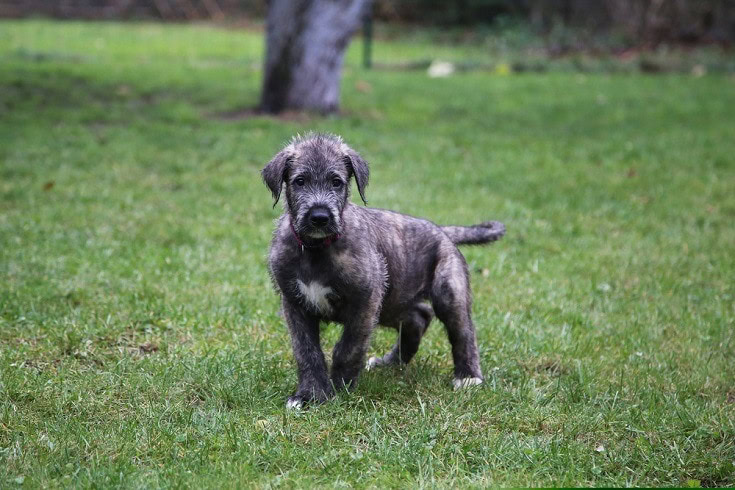
No one can ever accuse Irish Wolfhounds of misrepresenting their size. These dogs are huge even when they’re puppies — in fact, they’re as big as many full-grown dogs when they’re still babies. It’s not unusual for these dogs to weigh more than 100 pounds by the time they’re 6 months old.
That means that raising a Wolfhound puppy is much like raising a regular dog, except one that loves to play and gnaw on anything in their immediate vicinity. When they’re teething, they can do enormous amounts of damage; these dogs could destroy an entire tree if left to their own devices.
These playful mutts stay puppies for a long time too. They take forever to figure out how to use their long legs and gigantic feet, although that’s one skill they never fully master. These dogs are incredibly athletic and equally clumsy, and you’ll need to get used to getting bowled over on a regular basis.
Just because a puppy is the size of a regular dog doesn’t mean they should be treated like one, though. Their bodies are still developing, so you can’t be too rough with them or push them too hard during training. They’ll basically need to be handled with kid gloves for quite some time.
That can be challenging, though, because this is a high-energy dog. As a result, you’ll need to find ways to tucker them out that aren’t impact-heavy, which can be a challenge.
What’s the Price of Irish Wolfhound Puppies?
If you’re thinking about getting an Irish Wolfhound, you need to be aware of something up front: They’re going to cost you money. They eat a large amount, they have high vet bills, and they’re expensive to buy from breeders.
You should budget at least $2,000 to adopt a purebred Irish Wolfhound puppy, but don’t be surprised if you need even more than that. If you want one with top bloodlines, you may need to pay over $6,000.
You may have difficulty tracking down a breeder in your area, since these dogs aren’t as popular as other breeds. That may require you to search outside your immediate location to find one, and you may have to travel to pick it up.
With a large breed dog like this, finding a reputable breeder is absolutely essential. Check their references, inspect their facilities, and check out how their puppies behave. Irish Wolfhounds are prone to enough health problems under normal circumstances; you don’t want to exacerbate that by buying one from a breeder who hasn’t taken care of them.
You may be able to sidestep that whole process by finding a rescue group that caters to Wolfhounds. However, those are few and far between, so you may need to travel. You can also check animal shelters, but it’s extremely rare to find a purebred Wolfhound (or even a mix) at the pound.
3 Little-Known Facts About Irish Wolfhound
1. Their origin dates back to 100 B.C.E.
Irish Wolfhounds and their immediate forebears have been around for quite some time. They were originally bred as war dogs and could reportedly jump in the air to rip a man right off his horse.
Their ancestors were a breed called the Cu, which were favored by the likes of Julius Caesar. In addition to being used in battle, these dogs were called upon to hunt wolves, elk, and boar, which may have been even more dangerous than mounted warriors.
2. They’re the tallest dogs in the world.
There are a few other breeds (like Mastiffs) that can outpace Irish Wolfhounds in the weight department, but when it comes to sheer height, these dogs have no equal.
However, while they’re taller than Great Danes on average, the tallest dog of all time was actually Zeus, a Great Dane that stood 7 feet tall when on his hind legs. Irish Wolfhounds, on the other hand, usually only clock in at about 6’6” when on their hind legs.
One thing’s for sure, though: You’d better start putting the dog treats on top of the refrigerator.
3. The breed almost went extinct in the 19th Century.
The dogs were bred to hunt wolves, so when those animals were driven into extinction in Ireland in the late 1700s, the need for Wolfhounds plummeted as well. As a matter of fact, there are a few experts who believe that these dogs did go extinct.
The modern Wolfhound is largely a recreation of the original breed rather than a continuation of it. One dedicated breeder, Captain George Augustus Graham, attempted to revive the breed toward the end of the 19th century. To do so, he combined what few existing Wolfhounds he could find with Great Danes and Scottish Deerhounds, with at least one Borzoi and Tibetan Mastiff for good measure.
These “new” Irish Wolfhounds are every bit as imposing as their forebears, although they’re much less likely to drag a man off a horse (except by accident).
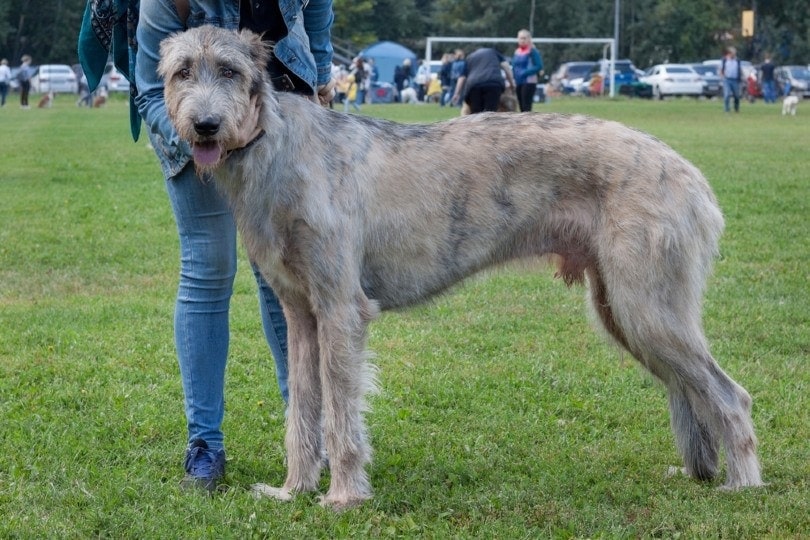
A Brief History of the Irish Wolfhound
Tales of Irish Wolfhounds date as far back as 100 B.C.E. However, it’s different to separate fact from fiction in the historical record, as these dogs were often the subject of tall tales — a fate befitting a dog this size, actually.
In addition to being used as hunting and war dogs, Irish Wolfhounds were favored by the Romans for use in their games. They were sometimes pitted against lions, tigers, men, and other dogs; however, their size and rarity meant that they were often paraded around to be gawked at rather than used for fighting.
The Romans and Celts weren’t the only ones that valued these massive dogs. When the Vikings invaded Ireland in 795 C.E., they quickly found a use for the native Wolfhounds. The dogs often show up in Nordic sagas, where they’re depicted as fierce war machines.
The animals were so valued, in fact, that they were often given as gifts between nobles. By the 12th century, owning them was restricted to members of the nobility.
Today, these dogs are still extremely popular in their native Ireland, although they’re not as commonplace in the rest of the world. Few breeds can match their storied history, though.
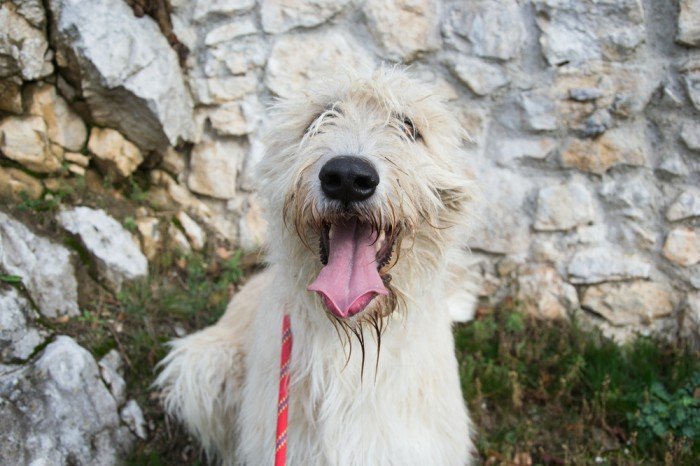
Temperament & Intelligence of the Irish Wolfhound
A dog as physically imposing as the Irish Wolfhound could cause real issues if they had an attitude problem. Fortunately, this breed is one of the sweetest and good-natured on the planet.
That doesn’t mean they’re as in-your-face with their affection as some other dogs. They’re usually reserved and laidback, preferring to let you come to them rather than forcing themselves into your bubble. They’re also quiet, only barking when they truly have something to say.
They’re extremely intelligent, and every single one of their movements is well-considered. They’re a methodical breed and have a good reason to do everything they do.
They bond closely with their families, but they’re still welcoming toward strangers. That doesn’t mean that they’ll jump all over company, but your guests can approach these dogs without fear of incident.
That makes them a poor guard dog in general (although their mere appearance could serve as a useful deterrent). They’re not likely to protect your stuff, although if anyone tries to attack their families, they’ll quickly make them regret it. Remember, these dogs used to pull armored men off of horses, so they’re more than capable of protecting your family from a random stranger.
Are These Dogs Good for Families?
Irish Wolfhounds make incredible family pets. They’re patient with children and are not prone to aggressiveness. They’re also laidback, which reduces the risk that your kid will get trampled by an overstimulated dog.
That being said, they can still step on a kid accidentally, so watch them at all times. This is not an animal that knows where their feet are at any given moment, so every member of the family should resign themselves to getting stomped on every now and then.
However, in many cases, it’s the children who will need to be watched around the dog, not the other way around. Irish Wolfhounds look like small ponies, but their frames cannot support being ridden like a horse, so make sure your kids don’t try to climb on (something that’s incredibly tempting to many children).
Due to their massive size — especially when on their hind legs — you need to take special care to train them not to jump on people. They can easily injure someone if they do this, especially elderly family members, so take that portion of the training process extremely seriously.
This is a breed with a fair amount of energy, which when paired with their size, makes them a poor fit for apartment dwellers. You’ll need a big yard (or at least access to a big park) so these pups can stretch out their legs on a daily basis.
Does This Breed Get Along with Other Pets?
These dogs are usually accepting of other creatures, and that extends to other dogs. They’re not likely to have issues with any other pooches in your home, making them an excellent option for a multi-dog household.
However, if the other dog decides to start something, the Irish Wolfhound can certainly throw their weight around in a hurry. You should monitor the dogs closely for a few days after introducing them, and keep their food and toys separate until you’re certain that they won’t cause a problem.
If raised around cats and other small animals, Irish Wolfhounds will likely be warm and receptive toward them. However, that hospitality isn’t likely to extend to small creatures outside the household, and they certainly love to chase stray cats, squirrels, and anything else that crosses their path.
Most of this behavior can be affected by your efforts to socialize the dog as a puppy. You should try to expose your Wolfhound to as many places, people, animals, and things as possible so they’re confident in new situations and unlikely to react poorly.
Also, if you have horses on your property, you may need to teach your Wolfhound not to chase them. These dogs love to run after animals large and small, but chasing a horse often ends poorly for the Wolfhound.
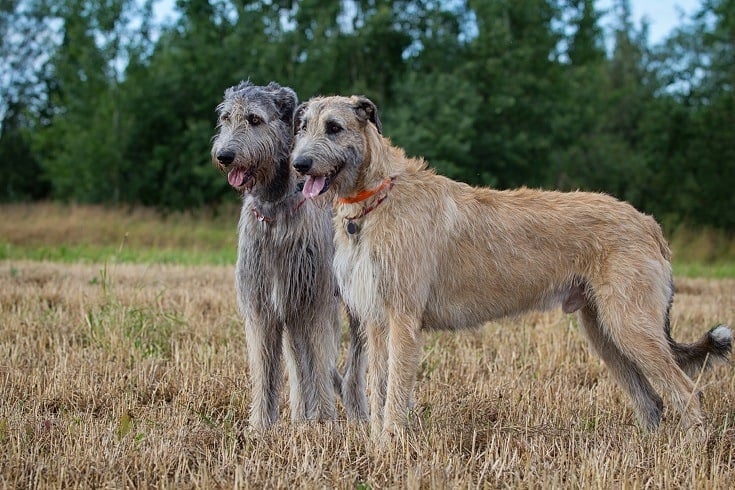
Things to Know When Owning an Irish Wolfhound
Irish Wolfhounds are a low-maintenance breed on a day-to-day basis, but they have several foibles that make raising one much different from owning another dog. Unfortunately, though, many owners have no idea what they’re getting into with this breed.
The information below should serve as a quick primer on Wolfhound ownership, telling you the basics that you should expect from these giant goofballs. However, keep in mind that this is only a general guide; every dog is an individual, and some of the information below may not apply to your specific Wolfhound.
Food & Diet Requirements
This is a huge animal with huge food needs. There’s no getting around that, so make peace with the fact that you’ll have to spend a great deal of money on kibble when you bring one of these beasts home.
Don’t be tempted to save money by skimping on kibble quality either. Wolfhounds are prone to all manner of health problems, and you can exacerbate these conditions by feeding them a low-quality diet. Every extra dollar you spend on a high-quality kibble will probably save you several more on vet care down the road.
Look for a high-protein kibble that uses quality ingredients. Real meat should be the first ingredient listed, and avoid anything with animal by-products, corn, wheat, or soy. All of these can have a negative impact on your dog’s health.
While these dogs can carry a few extra pounds better than some smaller breeds, you should still be careful about keeping them lean and trim. Obesity is awful for all dogs, but for larger breeds especially, as they have short enough lifespans as it is. The best way to extend the amount of time that you get with your Wolfhound is to make sure their weight is kept in check.
Be mindful of their weight as puppies, too. We realize that there’s nothing cuter than a fat puppy, but these dogs experience dramatic growth spurts, and you don’t want to put any extra strain on their joints during those times, as that can lead to problems down the road.
Exercise
Irish Wolfhounds are laidback but still need quite a bit of daily exercise. In fact, they’re one of the most energetic giant breeds on the planet, so take that into account before you get one.
That means you’ll need plenty of space for them to stretch out. Daily walks are great, but they’re probably not going to be enough to tucker these pups out, so they’ll need room to run. As a result, they may be best suited for life in rural areas.
You also have to be careful about how you exercise these dogs. They need low-impact activity, as you don’t want to put a great deal of strain on their joints and spine. That generally rules out jumping, so things like chasing Frisbees and agility training are usually a bad idea.
If possible, letting your Wolfhound swim is a great way to burn off excess energy without doing much damage to their bodies. Failing that, try to keep them from running at full speed if you can; instead, keep them at a trot.
You’ll need to have a formidable wall to keep these dogs contained, especially if they can see other animals outside their yard. Don’t rely on an invisible fence or anything of the sort because if these pups spot a squirrel, their prey drive will easily overrule any momentary discomfort they’d get from a shock.
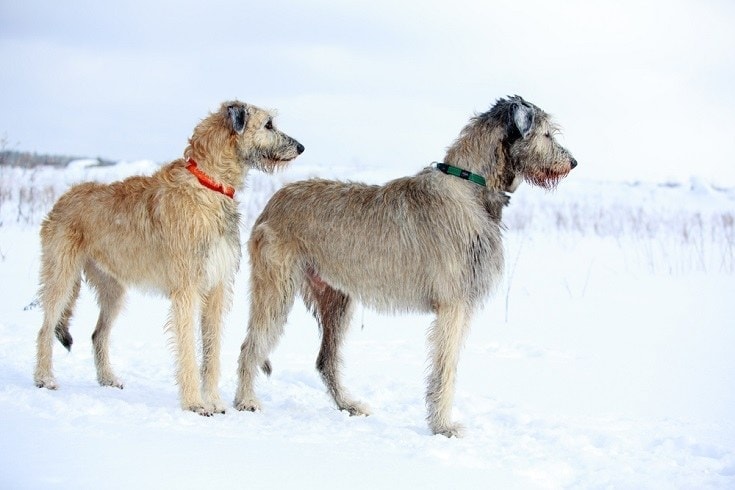
Training
These dogs are easy to train, as their combination of being both intelligent and eager to please make them quick studies when the clicker comes out.
However, they don’t respond well to punishment or other negative reinforcement techniques, as despite their formidable size, they’re actually quite sensitive animals. Being harsh with them will likely just cause them to withdraw rather than respond to your training.
Instead, try being patient and steady with them. Don’t be afraid to make them repeat actions over and over until they get them right, as they tend to be patient dogs. That shouldn’t be much of an issue, though, as they can usually pick up on new things quickly.
In addition to teaching them not to jump on people, you’ll need to try to get their impulsiveness under control. They love to chase after any animal they see, which can be a real problem if you’re attached to the other end of their leash. Teaching them, “leave it,” or similar commands may be the only thing that stops you from getting dragged all over the neighborhood.
These dogs love to please their owners, so you can likely train them with just a kind word and a few ear scratches. You can reward them with treats if you like, but don’t overdo it — again, obesity should be avoided at all costs.
Grooming ✂️
Irish Wolfhounds are considered to be average shedders, but that can change depending on the climate in which they’re kept. Remember, they were bred for life in Ireland, so they may not fare well during a Phoenix summer.
You’ll need to brush them thoroughly at least once a week, and a couple of times a year, they need to have their coat plucked to remove dead hair. This should likely be handled by a professional groomer.
They don’t need frequent bathing, so you can probably save that for when they’re visibly dirty. That’s a good thing too, as it’s unlikely that you have a tub big enough to easily accommodate these dogs (especially when they can step out so easily).
Their teeth should be brushed several times a week, and their nails should be trimmed as needed. Don’t let their nails grow too long, though, because that can throw off their gait, leading to spinal issues.
Health Conditions
Unfortunately, large breed dogs tend to be prone to more health conditions than smaller pups, and the Irish Wolfhound is no exception. These dogs don’t live long, and the ends of their lives are often marred by all manner of medical issues.
As a result, these dogs are incredibly expensive to insure, but it will also likely be incredibly expensive to pay for their vet bills out of pocket. That makes them a poor choice for owners who can’t afford to drop quite a bit of money on doctor visits.
That’s why it’s so important to make every effort to head off health issues at the pass, so to speak. Give them a high-quality kibble and don’t overfeed them; you may also want to start giving them glucosamine or another joint supplement at an early age.
This is also a big reason that finding a reputable breeder is so important. Dogs from puppy mills are often prone to more health issues than other animals, and Irish Wolfhounds don’t need any help in that department. Make sure you get a puppy that has started life off on the right foot — it will save you a bundle down the line.
With all that being said, here are the most common issues to watch out for if you own an Irish Wolfhound.
- Tail-tip injuries
- Osteochondritis dissecans
- Progressive retinal atrophy
- Food allergies
- Sensitivity to anesthesia
- Hip dysplasia
- Elbow dysplasia
- Bloat
- Cardiomyopathy
- Osteosarcoma
- Hereditary intrahepatic portosystemic shunt
- Von Willebrand’s disease
Male vs Female
Males are generally bigger than females, and by quite a bit — as much as 4 inches and 40 pounds, in some cases. Of course, you’re going to be dealing with a huge mutt either way, so you may not feel there’s much of a difference between a 180-pound dog and a 140-pound one.
Females tend to live a bit longer, but not by much; you may only get an extra few months to a year by bringing home a girl. They’re also a bit more independent, preferring to have you come to them, whereas males are much more likely to crawl into your lap and make themselves at home.
Beyond that, there’s not much in the way of differences between the two genders. Regardless of whether you decide on a boy or a girl, you’re likely to have a sweet, smart dog that keeps to themselves much of the time.
Final Thoughts:
Irish Wolfhounds are gentle giants who love to be around their families. They’re fairly energetic for a large breed, but they’re not as demanding as some other dogs, making them a relatively low-maintenance pet for any owner who has a yard big enough to support them.
Despite their size, don’t expect them to be much of a guard dog, as they’re far too accepting of strangers to protect your valuables. Then again, if anyone messes with you or your family, they’ll have one of the biggest pooches on the planet to deal with.
These dogs are expensive to own, as they require a large amount of high-quality kibble and can be prone to expensive medical issues later in life. That means they’re not for everyone; you likely need a big yard and plenty of disposable income to own one.
If you can afford it, though, you’ll have a loyal, lovable companion that’s sure to be the center of attention on every walk — especially if they’re dragging you through your neighbors’ lawn while chasing after a squirrel.
Featured Image Credit: 84kamila, Shutterstock

